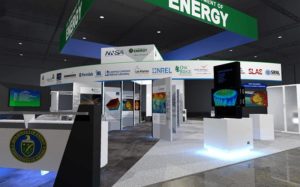WASHINGTON, D.C., Nov. 12, 2019 – The scientific computing and networking leadership of 17 U.S. Department of Energy’s (DOE’s) national laboratories will be showcased at SC19, the International Conference for High-Performance Computing, Networking, Storage, and Analysis, taking place Nov. 18-21 in Denver, CO.

Computational scientists from DOE laboratories have been involved in the conference since it began in 1988 and this year’s event is no different. Experts from the 17 national laboratories will be sharing a booth featuring speakers, presentations, demonstrations, discussions, and simulations. DOE booth (#925) will also feature a display of high performance computing artifacts from past, present and future systems.
Lab experts will also contribute to the SC19 conference program by leading tutorials, presenting technical papers, speaking at workshops, leading birds-of-a-feather discussions, and sharing ideas in panel discussions.
In addition to computational experts from the national labs, the DOE booth will feature work supported by the National Nuclear Security Administration computing centers at Lawrence Livermore, Los Alamos and Sandia National Laboratories, and DOE Office of Science’s HPC centers: the Argonne and Oak Ridge Leadership Computing Facilities and the National Energy Research Scientific Computing Center (NERSC) at Lawrence Berkeley National Laboratory. Engineers from DOE’s Energy Sciences Network (ESnet), which connects 50 DOE sites to their users and collaborators around the world through high-bandwidth networks, will discuss the role of networking in scientific discovery.
A full schedule of events can be found at http://scdoe.info/. Attendees can also follow the DOE booth on Twitter at @NatLabsHPC. In addition, attendees can learn more about career opportunities at many of the labs during a recruiting event to be held in the booth from 10 a.m.-12:30 p.m. Thursday, Nov 21.
Together, the talks, demos, discussions ,and electronic displays will exemplify DOE’s leadership in scientific discovery, national security and exascale computing. In particular, the three days of speakers at the DOE booth will give visitors insights into how HPC accelerates competitiveness, improves American research and development, and helps solve problems thought previously impossible.
Featured presentations on Tuesday, Nov. 19
- Stehpane Ethier of Princeton Plasma Physics Laboratory on “High-Fidelity Whole-Device Model of Magnetically Confined Fusion Plasma”
- Deborah Bard of Lawrence Berkeley National Laboratory discussing “Cross-Facility Science: The Superfacility Model at Lawrence Berkeley National Laboratory”
- Pacific Northwest National Laboratory’s Ang Li will present “Online Anomalous Running Detection via Recurrent Neural Network for GPU-Accelerated HPC Machines”
- Prasanna Balaprakash of Argonne National Laboratory discussing “Scientific Domain-Informed Machine Learning”
- National Energy Technology Laboratory’s Dirk VanEssendelft speaking on “TensorFlow For Scientific and Engineering HPC Computations: Examples in Computational Fluid Dynamics”
- David Womble from Oak Ridge National Laboratory on “Opportunities at the Intersection of Artificial Intelligence and Science”
- Keren Bergman of Columbia University will discuss “Optically Connected Memory for High Performance Computing.”
Wednesday, Nov. 20 talks are:
- Lawrence Livermore National Laboratory’s Brian Spears will discuss “Cognitive Simulation: Integrating Large-Scale Simulations and Experiments Using Deep Learning”
- Balint Joo and Graham Heyes of Jefferson Lab on “HPC at Jefferson Lab for Theory and Experiment”
- Brian Albright and Brad Settlemyer of Los Alamos National Laboratory will discuss “Co-design at Extreme Scale: Finding New Efficiencies in Simulation, I/O, and Analysis”
- Meifing Lin of Brookhaven National Laboratory will present “High Performance Computing for Large-Scale Experimental Facilities”
- Andrew Younge of Sandia National Laboratories on “Supercontainers for HPC”
- SLAC National Accelerator Laboratory’s Jana Thayer will presenting “Big Data at the Linac Coherent Light Source.”
The National Nuclear Security Administration will be represented by Lawrence Livermore, Los Alamos, and Sandia National Laboratories. DOE Office of Science will be represented by Ames, Argonne, Brookhaven, Lawrence Berkeley, Oak Ridge and Pacific Northwest National Laboratories; Fermi and SLAC National Accelerator Laboratories; Princeton Plasma Physics Laboratory; and Thomas Jefferson National Accelerator Facility. The Office of Energy Efficiency and Renewable Energy will be represented by the National Renewable Energy Laboratory, the Office of Environmental Management by Savannah River National Laboratory, the Office of Nuclear Energy by Idaho National Laboratory, and the Office of Fossil Energy by the National Energy Technology Laboratory.
About the Department of Energy
The Department of Energy is the nation’s leading provider of high-performance computers. For more than six decades, the DOE national laboratories have helped develop and deploy many of the world’s most powerful supercomputers. Researchers from around the nation use these computing resources to tackle the most important scientific challenges facing us. From developing new energy sources to finding better ways to store energy, from protecting our health to protecting our national security, from improving transportation to making our world safer, supercomputers play a critical role in advancing our scientific understanding and maintaining our scientific, technical and economic leadership.
Source: Department of Energy



























































